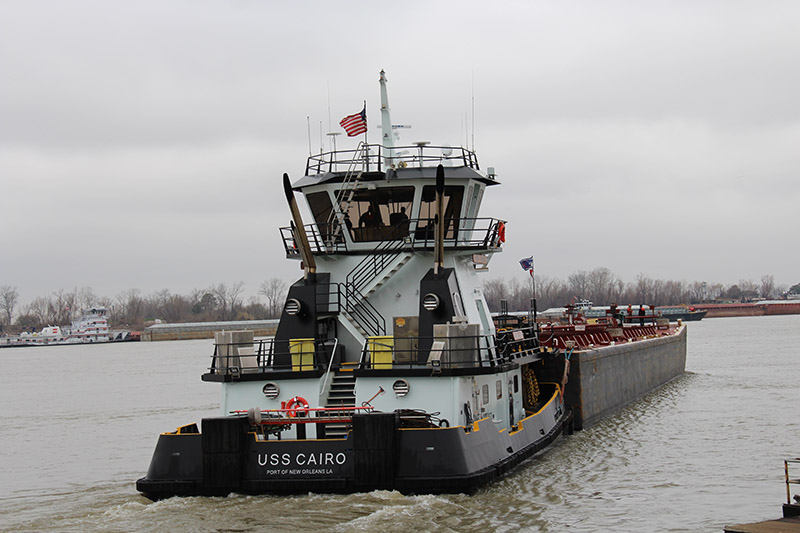With the slow down in the offshore energy sector, equipment suppliers are looking at other areas of the workboat market that have been relatively unexplored, perhaps you could say neglected.
Most towboats that ply the inland waterways have traditionally been controlled with a conventional prop and rudder combination. Several Z-drive towboats have been built since 2008 — most with thrusters from ZF Marine — but Z-drive propulsion has yet to take off on the inland rivers. Now, however, with the slow down offshore, Z-drive manufacturers are working harder to make inroads in this relatively untapped market.
Thrustmaster in Houston is one of them. “We are focusing on the inland waterways market and are trying to get them to start considering and seeing the values and benefits of using Z-drive thrusters,” said Adam Jost, applications manager with Thrustmaster.
It’s often not an easy sell. Towboat operators can be reluctant to try something new. It’s the “I’ve been operating this way for years and my father and grandfather before me were doing the same” mentality.
Another hurdle people like Jost run into is the question of what happens when Z-drives must deal with river flotsam. Say a Z-drive towboat hits a floating tractor tire or log, operators worry that a catastrophic failure would result and they don’t want to take that risk. With the silt, sand and floating and sunken trash that can be found on the inland waterways, a Z-drive thruster designed for blue water use probably wouldn’t last very long on an inland towboat. A Z-drive thruster “that’s more durable, more robust” is needed to operate on the rivers, said Jost.
Brownwater Z-drives

The lower gearbox and nozzle assembly of a Thrustmaster TH1500MZ Z-drive on a drydocked towboat. Thrustmaster photo.
So Thrustmaster developed a series of Z-drive thrusters for the brownwater inland market that range from 500 hp to 4,000 hp. They come with a steel welded housing and body, as opposed to ductile iron, that’s built to last longer in brownwater.
Thrustmaster’s Z-drives for the in.land waterways market come standard with a stainless steel propeller, as op.posed to a nickel-bronze or aluminum prop. And it’s “not a one-size fits all thruster mount,” said Jost. The mount is custom made for a boat’s hull. “It’s a perfect fit for the hydrodynamics of the vessel as well as the drive line configuration between the thruster and the customer’s diesel engine or electric motor.”
When the thruster grabs hold of a tractor tire or log, often it will seize up the propeller and gear set. “And the en.gine will continue to try and drive the gears and will tear the gears to bits,” Jost said.
Thrustmaster’s inland waterway Z-drive thrusters avoid this potential catastrophe with a torque-limiting coupling. “When it sees a torque spike as the result of a tractor tire or a log, it instantaneously relieves the pressure by breaking free the drive-line shaft from the thruster,” said Jost. While the diesel engine continues running, the thruster stops, without destroying the gear sets. The thruster can usually be repaired in the water. Jost said South American operators often turn one thruster toward the jammed thruster and blow out the debris. “Then you reset the coupling and are up and running.”
Barge Thrusters
Omnithruster, Twinsburg, Ohio, has introduced a wireless barge thruster. It’s a wireless system between the barge and towboat.
Problems can arise when electrical cables, also called umbilical cords, run from the tug or towboat to the barge. Deckhands who aren’t careful can dam.age the connectors or the cable. “Or they forget that the cables were con.nected and pull away from the barge and break it. Wireless allows them to do away with all that,” said Kurt Wid.mer president of Omnithruster.
There are also barge length issues. “They are getting really long,” said Widmer. “Thus the amount of copper that has to run from the forepeak of the barge to the stern and then up to the tugboat gets to be an ungainly length.”
In contrast, a wireless system is much easier to install. Basically all that’s needed is an antenna on the barge and tug, along with a small electronics box with a wireless radio and power supply in the tug.
In the case of the boat losing power or the signal dropping off, the local control panel on the barge takes over after a two-second-signal loss. “It’s a built-in safety to take it back to local control,” Widmer said.
If a tug operator has an Omnithruster that’s wired in to the tug and it was installed in the past 10 years, it’s pos.sible to upgrade it to wireless. You just replace “the hard-wire connectors with a wireless radio,” Widmer said.
A wireless thruster seems fairly simple and easy to deal with. But when it comes to actually getting inland operators to install wireless systems, Omnithruster has run into the same objection that has plagued Z-drive manufacturers.
“It’s a mindset,” said Widmer, who added that engineering the wireless thruster wasn’t as complicated as convincing customers of its viability. “Everyone is sort of use to hard wire situations. They are used to plugging cables in.”
Wireless controls are going into three 80,000-bbl. barges being built at Conrad Shipyard in Morgan City, La. “These will be the first three that the new wireless system goes on,” said Widmer. The wireless thrusters will be Omnithruster HT 600s (600 hp).
Offshore Thruster
Schottel USA, Houma, La., recently introduced an underwater demountable thruster called the LSU series, named after Louisiana State University. Its target market is drilling rigs or wind-farm vessels, said Hank Morgan, Schottel’s vice president of sales and market.ing. “It’s for something that requires multiple thrusters, is very large, stays offshore and doesn’t get into a dry.dock very often.” The LSU series has a power range of 6,400 hp to 7,400 hp.
If the thruster has to be repaired, the unit can be removed underwater, brought up on deck to be worked on, then put back in the water and re-installed.





